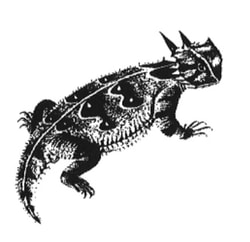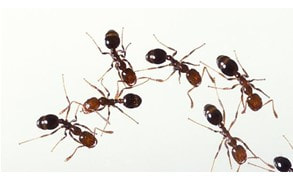Meet Maximilian
By Glynda Pflug

In one of the showcases at Window on the Plains Museum, a special little creature, a horny toad, horned lizard or Phrynosoma Cornutum, sits on a pile of rocks just waiting to attract the attention of visitors. Many visitors pass the showcase not even seeing him, thinking it is a showcase filled with rocks.
Some who notice the little reptile tap on the glass, trying to get him to move. Others inquire what we feed him.
He is very realistic, but actually, he is a fiberglass mold that was expertly painted by artist Carolyn Stallwitz. He blends perfectly with his environment, which is what horny toads do in order to stay alive.
Some who notice the little reptile tap on the glass, trying to get him to move. Others inquire what we feed him.
He is very realistic, but actually, he is a fiberglass mold that was expertly painted by artist Carolyn Stallwitz. He blends perfectly with his environment, which is what horny toads do in order to stay alive.
How Do Horny Toads Protect Themselves
- Horny toads are gentle creatures, but when agitated, they can inflate their bodies and use their spines for protection.
- They can run fast, stop and blend in with their surroundings.
- They can squirt blood at their attackers. The blood can be sent forward or backward as much as 4 feet.
Horny Toads Disappearing?
- There used to be a lot of horny toads, but they are disappearing.
- Some are being run over on highways where they are warming themselves on the pavement.
- They are killed in farming areas where tractors and plows are working.
- As towns and cities are growing, the area where horny toads live is becoming smaller.
- Pesticides that are used to kill insects are harmful to horny toads.
- The horny toad's primary source of food is red ants. Red ants beds are being killed to protect humans from being bitten.
- How can we help protect the species? Do not touch them! If you see one, just look at it or take a picture.

What Do Horny Toads Eat?
- The horny toads is "insectivorous," meaning they eat insects.
- Their favorite food is harvester ants (red ants). They can eat as many as 70 to 200 per day.
- They may catch a beetle, grasshopper, spider or other small insect.
- To catch an ant, they quietly creep up to an ant trail and wait. When an ant come, they take a step or two and thrust their long tongue to catch it.
- They swallow their food whole.
How Maximilian Got His Name...
The fiberglass replica of our horny toad came to the museum in 2002 and a skit was developed to teach about the little reptile.
A costume was made to wear in the skit and a special song was written.
The song was named "Nameless, the Horny Toad" and a contest was held among fourth grade students to name the little creature.
The winning name was "Maximilian" and the song title was changed.
The winner of the contest is recognized on a sign that hangs near the showcase. An award was given to the winner.
The fiberglass replica of our horny toad came to the museum in 2002 and a skit was developed to teach about the little reptile.
A costume was made to wear in the skit and a special song was written.
The song was named "Nameless, the Horny Toad" and a contest was held among fourth grade students to name the little creature.
The winning name was "Maximilian" and the song title was changed.
The winner of the contest is recognized on a sign that hangs near the showcase. An award was given to the winner.
Facts About Horny Toads
- Adult horny toads are about 4 to 6 inches long.
- Baby horny toads can be as small as a nickel.
- They have 5 claws on each leg.
- They may live to about 7 years old.
- There are 14 species of horny toads.
- They are not actually toads, but are reptiles.
- The little reptiles are cold blooded creatures.
- They live in Texas, New Mexico, Kansas and Oklahoma
- They are desert creatures so they do not need much water. They get some off plants or from puddles. They can arch their back to make rain water drops run toward their mouth.
- Some horny toads lay eggs, other give birth to babies. They lay eggs in the spring, right after they come out of hibernation. The female finds a place for a nest and digs a slanted tunnel into the sand. She lays 13 to 45 eggs and packs them in the soil into layers. She may stay briefly at the nest, but when she leaves, she never returns.
- At night, they burrow into the sand, come out at sunrise and bask in the sun to warm up. If it gets hot, they move to a shady place or may climb a bush if the ground is too hot.
- Horny toads are a protected species since 1967. They were put on the threatened species list in 1977 and cannot be captured, possessed transported or sold without a special permit.
- The horny toad was named the Texas State Reptile in 1992.
- The horny toad is "insectivorous," they eat insects.